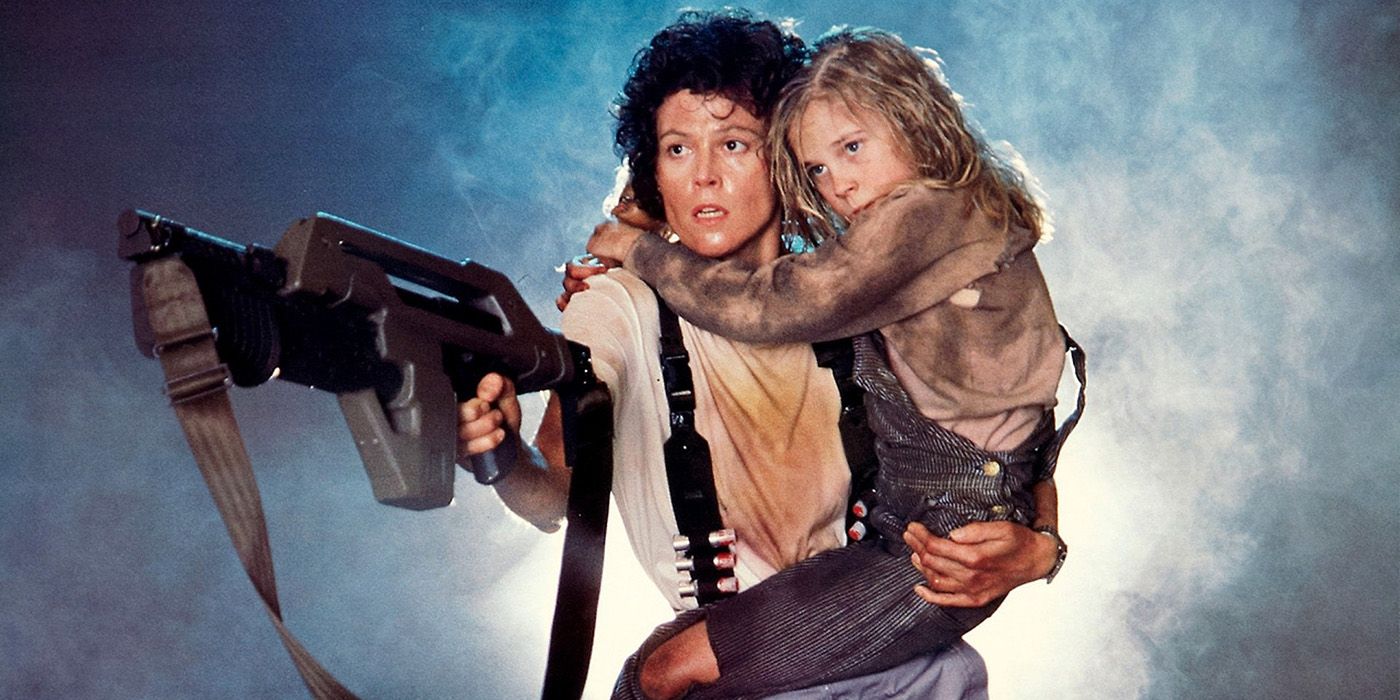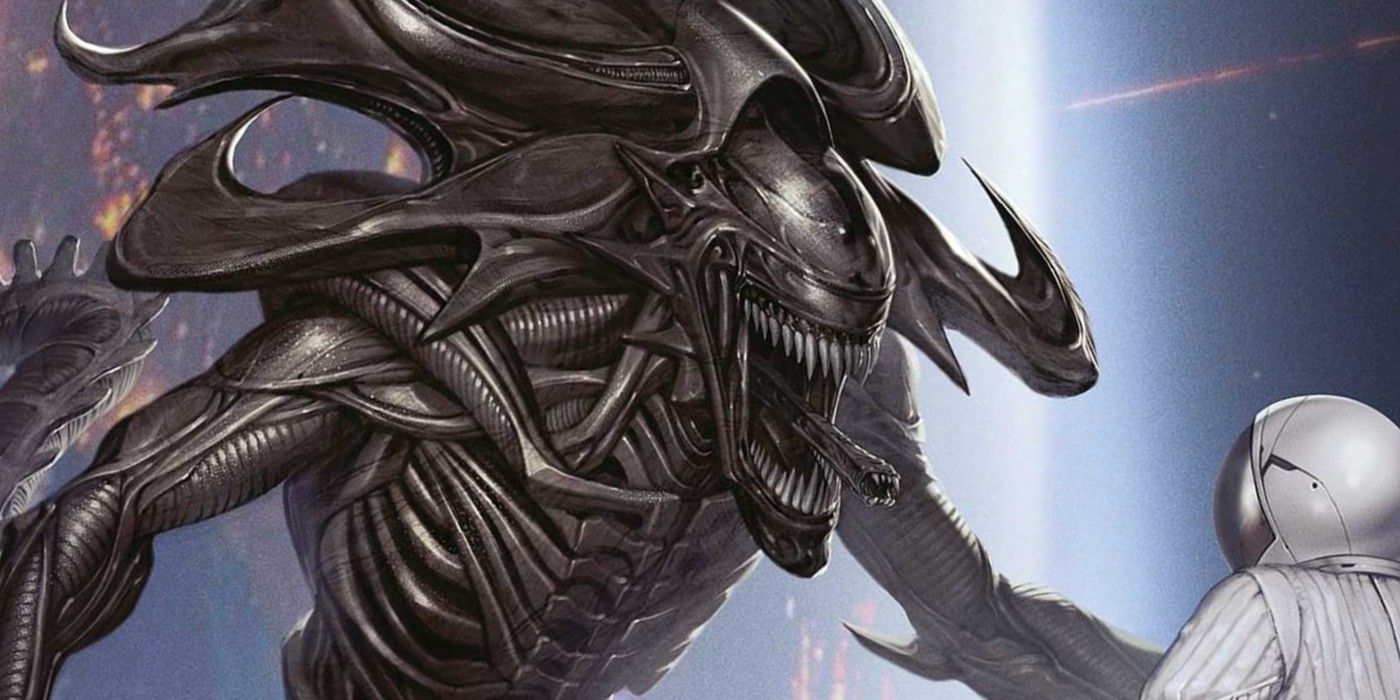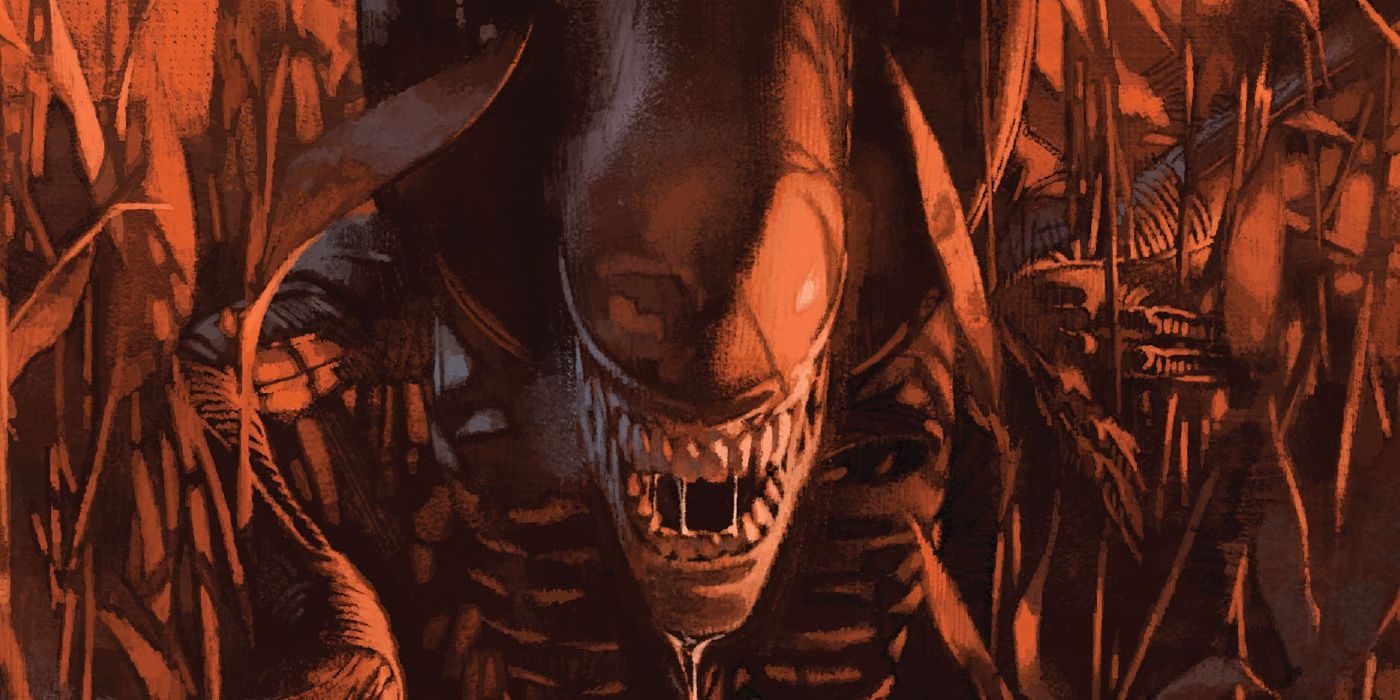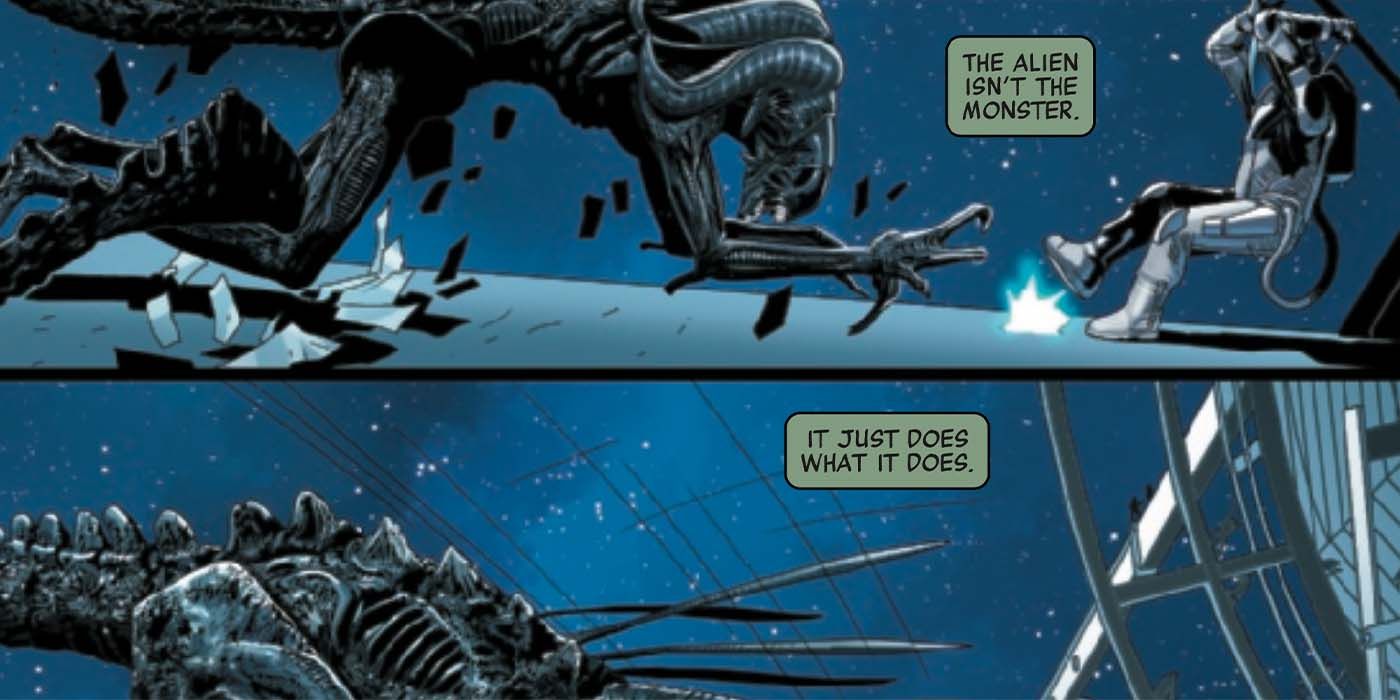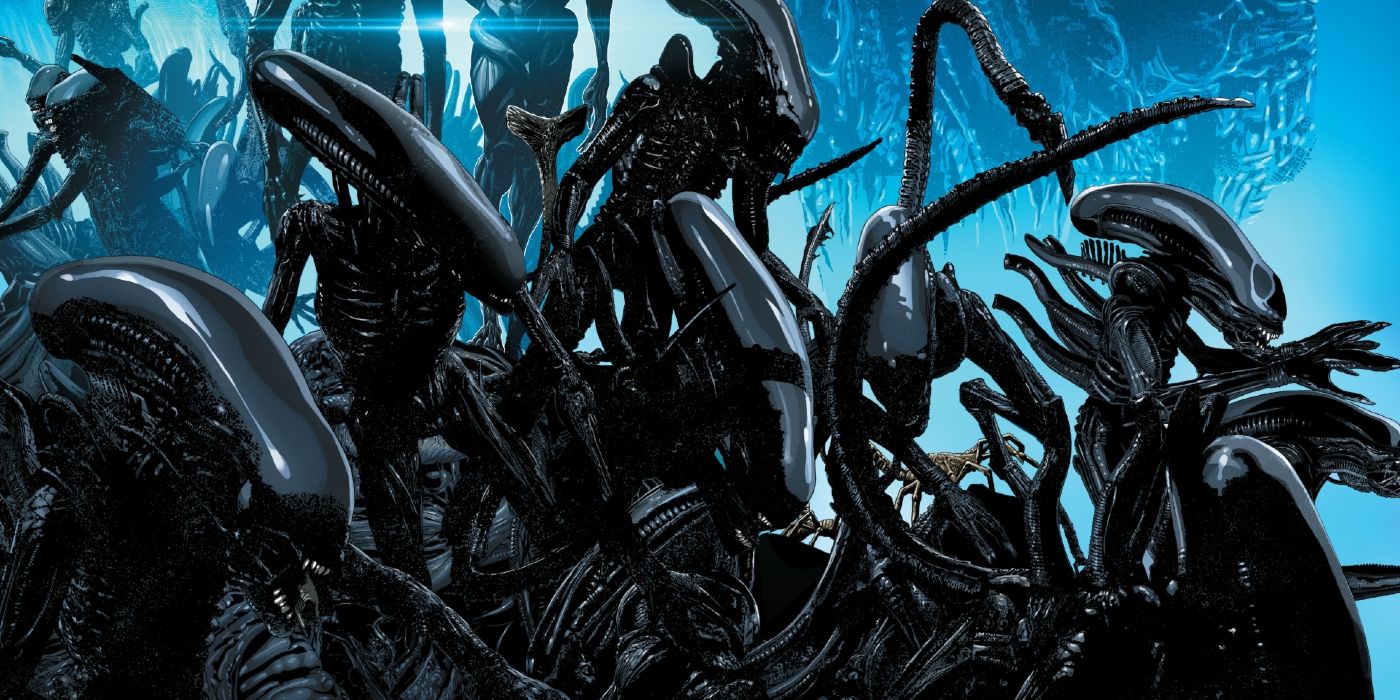A good horror story like Alien leaves fans hungry for more, a fact which Marvel Comics is taking full advantage of. Now entering a new phase in the franchise's history with a series from writer Phillip Kennedy Johnson, artist Salvador Larroca, colorist Guru-eFX, and letterer Clayton Cowles, it isn't difficult to imagine why Alien has been such a lingering force in popular culture. Emerging in 1979, at a time when space travel was romanticized in movies and television shows such as Star Wars and Star Trek, Alien ripped open the genre's façade to tell a story that was stooped as much in science fiction as it was in horror. Space was no longer a blank canvas for humans to project their most noble ideas onto, but an unforgiving void filled with monsters beyond all imagination. The ideas that the first Alien film put forth about exploration and human endurance radically took both horror and science fiction to new heights, imbuing it within the nightmarish silhouette of the xenomorph.
And yet today, the most expansive work in the Alien franchise is not being done on film, but in its Marvel Comics series. Without the cinematic attributes that gave Alien such an immersive sense of terror in 1979–its sound design, editing, and the illusion of reality inherent to all live action films–Marvel's Alien series has managed to invigorate the franchise by understanding exactly what horror comics offer from an expressive point of view. While other horror movies have been brought to the world of comics, such as The Conjuring, they have suffered from trying to compete with the scariness of their original films. More than any other comics adaptation of a horror film or franchise, Marvel's Alien succeeds because it understands that it will never be able to replicate the same type of fear from Ridley Scott's film onto the page. In fact, it is disinterested in having its worth based entirely on scares to begin with.
By not trying to compete with the scariness of the films, Marvel's Alien exposes an under-recognized truth about horror comics: they are not necessarily meant to be "scary" as much as they are meant to be creatively limitless. A comic adaptation of a stellar horror film will probably never be as terrifying as the film itself, and there is nothing wrong with that. But what a horror comic adaptation should do is strive to bring the ideas of the original film to new significance. As Alien evidences, horror is more creatively free than any other storytelling genre. Approaching horror comics only for the affective experience of trying to scare readers misses out on the genre's potential.
By expanding on the existing ideas that made the original 1979 film so terrifying, Marvel's Alien series digs into the reasons why audiences were meant to be afraid of the xenomorphs in the first place. Rather than trying to add more fodder to the franchise's fear machine, the Alien comics unpack the attitudes and perspectives that originally shaped the audience's experience of fear. In doing so, the Alien comics aren't so much participants in the franchise's brand of scares as they are critics of it. Horror is more than a provocation of fear, it is a complex reflection of how people expect the world to exist around them, and Alien's comics showcase how powerful this idea is in practice.
At Its Core, Horror Is An Exercise In Perspective, Which 'Alien' Masters.
As an art form based in text and still images on a printed page, comics are uniquely suited to horror's most basic principles: perspective and expectation. Something becomes scary to an audience when their perspective and expectations of it are manipulated. They might not think twice when they hear a floorboard creak in real life, but in A Quiet Place, it is utterly terrifying. Similarly, the presence of giant killer shark in Jaws changes the audience's perspective of beaches as a places of harmless fun to the stuff of nightmares. With the creative freedom that comics offer, perspective and expectations can be subverted in an endless number of ways, limited only by the imagination of creators.
Thus far, Marvel's Alien has been committed to showing a different perspective of the franchise's basic premise while also anticipating readers' expectations. Given that the franchise is more than forty years old, fans have a solid set of expectations from a piece of Alien media. But rather than playing directly into these expectations every time, Alien carefully subverts them, calling attention to why fans expected something to happen in the first place. This is also significant, because the comics don't waste energy trying to replicate the same mechanics of Alien's scares, through perspective and expectation, onto the page.
'Alien' Takes Horror's Most Basic Elements And Uses Them To Bring New Insight On The Franchise's Story.
Given the role that expectation plays in horror stories, Alien has made a point to subvert its own tropes, thereby making the case for why horror movie comic adaptations should be seen as creatively expansive opportunities. This has primarily been achieved through the first arc of the series that was told in Alien #1 through #6. Though the plot of the story followed a familiar track, with a group going to investigate a station infested by xenomorphs, this premise expanded into a meaningful exploration into the grand purpose of the xenomorphs and their conflict with humans. The protagonist, Gabe Cruz, realized that the xenomorphs were acting not in a deliberately malicious way against humans. They were protecting their homes and offspring much like he would as a father.
Considering that a great bulk of Alien's legacy as a franchise is the spectacle of the fights between humans and xenomorphs, this moment of clarity for Cruz while in the heat of battle brought an unexpected sense of depth to the comics' story. In this way, Marvel's Alien takes the foundations of horror as a genre, achieved through manipulations of perspective and expectation, and repurposes them for a discussion about why the xenomorphs should be seen as horrifying in the first place. In other words, the horror elements of the story are not meant to just scare readers, but to also make them think about why they should be scared.
Comic adaptations of horror films are becoming more and more common today. As franchises make their transition to the page, they face a question of what they want out of bringing their film series to comics. The differences between horror comics and horror films should be recognized plainly for what they are, so that future comic adaptations can be built more around filling in the thematic gaps of the films they are based on rather than only trying to scare their readers. Ultimately, if fans want the experience of being scared, they will probably opt to watch a horror film over reading a horror comic. It is a creative dead end for comic adaptations to view themselves solely as vehicles for scares.
Horror comics take advantage of the freedom inherent to the genre because they exist in a graphic format. And while they may not ever be as "scary" as horror films, horror comics provide a crucial avenue for discussing themes in a dramatic context. For instance, Something is Killing the Children uses monsters that feed off of children as a way to explore a theme of adolescent loneliness. The bloody action sequences just externalize the emotional conflict at the heart of the story. In this sense, it would be remiss of publishers to not consider their adaptations of horror films within the potential of a new format. If a franchise as old as Alien can be made fresh within a few issues of Marvel Comics, then the future truly can be limitless for horror film comic adaptations.

